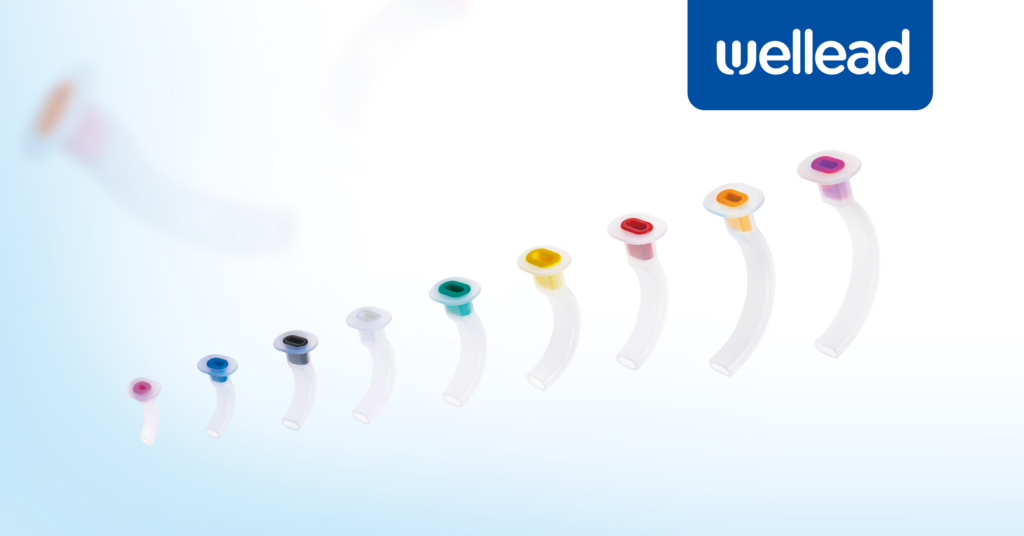The Guedel oropharyngeal airway is a curved, rigid channel that lifts the tongue away from the posterior pharyngeal wall in an unresponsive patient to secure a patent airway without active protective reflexes. It has a hollow core for suctioning and ventilation through the lumen.
- It is usually disposable.
- It is typically made of rigid plastic or hard rubber.
- It is positioned on the roof of the mouth, with the tip located at the base of the tongue.
- It has four main parts: the flange, airway channel, biting block, and distal tip.

The Guedel Airway Use
Inserting a Guedel oropharyngeal airway is intended to prevent airway obstruction caused by tongue prolapse, maintain short-term airway patency, and facilitate clearance of tracheobronchial secretions. It is primarily used in unconscious patients.
Essentially, it must be selected based on the patient’s anatomy to avoid pressure on the epiglottis or damage to soft tissues.
Oropharyngeal airway insertion should be performed gently to minimize trauma to the palate. Its rigid flange helps prevent biting and maintains an open airway. Proper positioning must be evaluated to ensure airway patency, as improper placement can cause further airway obstruction or trigger the gag reflex in semiconscious individuals.
Main Components of the Guedel Oropharyngeal Airway
The Flange
The flange on the Guedel oropharyngeal airway is wide and rigid. It prevents the device from being inserted too far into the oropharynx. Meanwhile, it offers a secure surface for clinicians to grip. The flange might have indicators for size. It helps distinguish adult from pediatric variations. Most designs have a smooth rim to decrease tissue trauma. Some flanges are color-coded to help categorize length at a glance. It’s handy during rapid airway management since the wrong size may worsen obstruction rather than improve it.
In airway procedures, an anatomically contoured flange disregards lip compression. It lets you align the airway with the oral structures to lower friction points. Apart from that, it also keeps the oropharyngeal pathway open to gas flow and suction.
The Airway Channel
The Guedel oropharyngeal airway’s central channel is the airflow conduit. It extends from the flange end to the distal tip. The channel is elliptical for lower internal resistance. It permits the passage of air, oxygen, or anesthetic gases.
The design also renders suction catheters easier to use. Without a patent airway channel, secretions might pool and compromise ventilation. Some Guedel oropharyngeal airway manufacturers reinforce the channel with rigid polymers. That limits collapse under external pressure. In many procedures, clinicians will place the Guedel oropharyngeal airway and insert a suction catheter through this channel. It clears the airway of secretions.
The dimensions of the channel and its rigidity are key to airway maneuvers.
The Biting Block
The biting block is between the flange and the channel. It withstands occlusive force from a patient’s jaws. The component protects the teeth and the device itself.
During deep sedation or emergence from anesthesia, patients may bite down. The device could deform or shatter if the airway Guedel lacked a strong biting block. That would prompt sudden airway compromise. The biting block is made from high-impact plastic. It must retain shape under repeated stress. It is also a safety net when patients have partial protective airway reflexes. With an open channel through the Guedel oropharyngeal airway, the biting block thwarts airway occlusion in high-risk moments.
The Distal Tip
The distal tip of the Guedel oropharyngeal airway sits in the oropharynx behind the base of the tongue. It is angled or curved to lift the tongue away from the posterior pharyngeal wall. The shape depends on the design.
A well-curved tip can decrease contact with the epiglottis and uvula. It also lowers trauma risk if the device is advanced. The distal tip must be smooth to circumvent mucosal injury. Some Guedel oropharyngeal airway models have a reinforced tip to help guide suction catheters. Others have extra channels on the tip to adjust airflow around the tongue.
The placement of the distal tip is key. Improper positioning can trigger gag reflexes or partial airway obstruction. Over-insertion may cause laryngospasm in some sensitive patients. So, clinical success and safety of the Guedel oropharyngeal airway depend on distal tip design.
How to Insert Guedel Oropharyngeal Airway
Choose the correct size while matching mouth-corner to jaw-angle length, lubricate lightly, and insert the Guedel oropharyngeal airway upside down along the hard palate. Rotate 180 degrees once past the tongue’s midpoint. Watch for tongue displacement or gag reflex for no dental trauma. Confirm patency by observing equal chest expansion with ventilations.
Additionally, for children, it is preferable to insert the oropharyngeal airway directly over the tongue using a tongue depressor (without twisting 180 degrees).
Oropharyngeal Airway (Guedel Type) from Well Lead Medical
Guedel oropharyngeal airways from Well Lead Medical are smooth and integrated for patient comfort and safety. Color-coded bite blocks help identify sizes and avoid airway blockage from biting.
Our selection of sizes from 40mm (pink, Cat. No. A06B020410) to 120mm (purple, Cat. No. A06B021210) fits different patient anatomies and lessens procedural airway obstruction.
Visit Well Lead Medical’s official website for more details.

